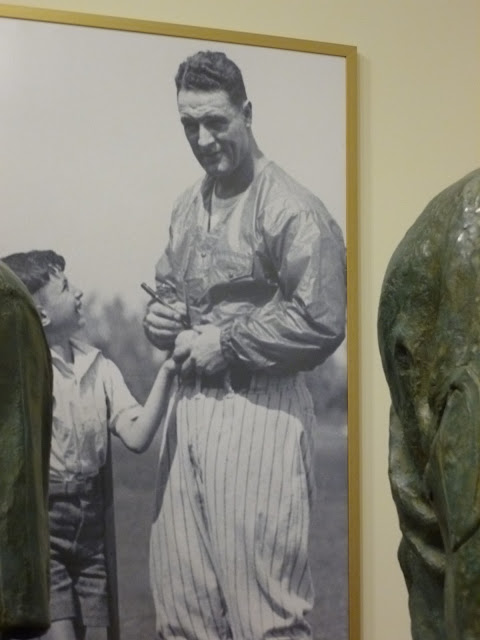Henry Louis "Lou" Gehrig
Cooperstown, NY
N 42° 42.003 W 074° 55.389
Short Description:
A statue of Lou Gehrig is one of three on display in the lobby of the National Baseball Hall of Fame at 25 Main Street, Cooperstown, NY. Each person was a model of character and courage, each in their own way.
Long Description:
A life size bronze statue of Lou Gehrig depicts the Hall of Fame first baseman wearing his New York Yankee uniform, a team for which he played for his entire 17 season major league career. Gehrig is standing with his legs slightly spread on a circular bronze plinth. He has both hands placed on top of a baseball bat, left over right, which he holds vertically in front of him.
The sign explains the purpose of the display:
CHARACTER AND COURAGE
Cast bronzes by Stanley Bleifeld
Becoming a Hall of Famer takes more than just a great baseball
career. Off-the-field challenges -- and how those challengers are
met -- reveal an inner character that serves men and women
throughout their lives. The life experiences of Lou Gerhig,
Jackie Robinson, and Roberto Clemente stand out above all.
Each faced personal and social obstacles with strength and
dignity that set an example of character and courage for all
others to follow.
Made possible through a generous donation by Robert Crotty
Henry Louis Gehrig was born in New York City to German immigrant parents on June 19, 1903. He attended New York City schools and Columbia University. While at Columbia he was recruited to play baseball by the New York Yankees. He began his major league baseball career on June 15, 1923.
On June 1, 1925, Gehrig began a 14 year streak of 2310 consecutive games played, earning him the nickname "The Iron Horse." Along the was he amassed a series of accomplishments that made him , by consensus, greatest first baseman in the history of the game.
In the spring of 1939 it became obvious that something was physically wrong with the once great player. He could not bat with power nor run the bases. A trip to the Mayo Clinic in Rochester, MN revealed he was suffering from amyotrophic lateral sclerosis (ALS), a progressively debilitating disease with no known cure. On June 21, 1939 he retired from baseball. The New York Yankees proclaimed July 4, 1939, "Lou Gehrig Appreciation Day." To a sold out crowd at Yankee Stadium Gehrig gave his famous "The Luckiest Man on the Face of the Earth" speech, this despite knowing he was dying from the disease that would later bear his name, Lou Gehrig disease.
The New York Yankees retired his uniform number "4", making him the first player in Major League Baseball history to have his number retired. On December 7, 1939, Lou Gehrig was elected to the National Baseball Hall of Fame. He died on June 2, 1941 at age 37, and is buried in Kensico Cemetery in Valhalla, NY.



No comments:
Post a Comment